
Gamma Pegasi is a star in the constellation of Pegasus, located at the southeast corner of the asterism known as the Great Square. It has the formal name Algenib ; the Bayer designation Gamma Pegasi is Latinized from γ Pegasi and abbreviated Gamma Peg or γ Peg. The average apparent visual magnitude of +2.84 makes this the fourth-brightest star in the constellation. The distance to this star has been measured using the parallax technique, yielding a value of roughly 470 light-years.
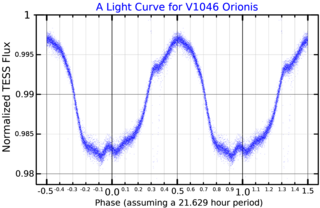
HD 37017 is a binary star system in the equatorial constellation of Orion. It has the variable star designation V1046 Orionis; HD 37017 is the identifier from the Henry Draper Catalogue. The system is a challenge to view with the naked eye, being close to the lower limit of visibility with a combined apparent visual magnitude of 6.55. It is located at a distance of approximately 1,230 light years based on parallax, and is drifting further away with a radial velocity of +32 km/s. The system is part of star cluster NGC 1981.

HD 49976 is a variable star in the constellation of Monoceros. It has the variable star designation V592 Monocerotis, while HD 49976 is the identifier from the Henry Draper Catalogue. It has a white hue and is near the lower limit of visibility to the naked eye, having an apparent visual magnitude that fluctuates from 6.16 down to 6.32 with a 2.976 day period. Based upon parallax measurements, it is located at a distance of approximately 337 light years from the Sun. The star is drifting further away with a radial velocity of +19 km/s.

ET Andromedae is a binary star system star in the northern constellation of Andromeda. It has an apparent visual magnitude of 6.48, placing it at the nominal limit for visibility with the naked eye. The distance to this system can be estimated from its annual parallax shift of 5.42 mas, which yields a value of 602 light years.

BX Boötis is a star in the northern constellation of Boötes. It is a dim star near the lower limit of visibility to the naked eye, having a nominal apparent visual magnitude of 6.35. Based upon an annual parallax shift of 10.81 mas, it is located 302 light years away. At that distance, the visual magnitude of the star is diminished by an extinction of 0.13 due to interstellar dust. It is moving closer with a heliocentric radial velocity of −11 km/s.
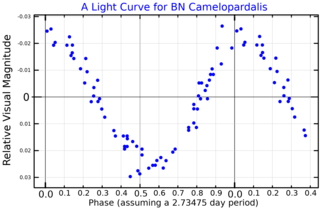
BN Camelopardalis is a suspected astrometric binary in the northern circumpolar constellation of Camelopardalis. It appears as a variable star that is visible to the naked eye as a dim, white-hued point of light with an apparent visual magnitude that fluctuates around 5.49. The system is located at a distance of around 310 light years from the Sun based on parallax, and is drifting further away with a radial velocity of +9 km/s.

Chi Ophiuchi, Latinized from χ Ophiuchi, is a variable star in the equatorial constellation of Ophiuchus. It has a blue-white hue and is faintly visible to the naked eye with an apparent visual magnitude that fluctuates around 4.22. The distance to this object, as determined from parallax measurements, is approximately 500 light years, but it is moving closer to the Sun with a radial velocity of −19 km/s. This star is a proper motion member of the Upper Scorpius sub-group in the Scorpius–Centaurus OB association; the nearest such co-moving association of massive stars to the Sun.

HD 21278 is a binary star system in the constellation Perseus, located within the 60±7 million year old Alpha Persei Cluster. It has a blue-white hue and is visible to the naked eye with a combined apparent visual magnitude of 4.99. The system is located at a distance of approximately 580 light years from the Sun based on parallax, and it is drifting further away with a radial velocity of +1.20 km/s.
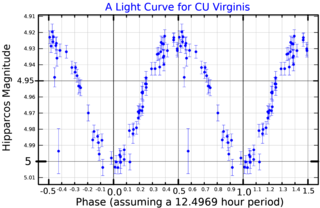
CU Virginis is a single star in the equatorial constellation of Virgo. It has an apparent visual magnitude of 4.99, which is bright enough to be faintly visible to the naked eye. The distance to this star can be estimated from its annual parallax shift of 13.9 mas, yielding a separation of 234 light years.

21 Persei is a single, variable star in the northern constellation of Perseus, located about 331 light years away from the Sun. It is visible to the naked eye as a faint, white-hued star with an apparent visual magnitude of 5.10 km/s. The object is moving further from the Earth with a heliocentric radial velocity of +8.5 km/s. It has the variable star designation LT Persei; 21 Persei is the Flamsteed designation.

9 Ceti is a star in the equatorial constellation of Cetus. It has the variable star designation BE Ceti, while 9 Ceti is the Flamsteed designation. It has an apparent visual magnitude of 6.4, which is below the limit that can be seen with the naked eye by a typical observer. Based upon parallax measurements, this star is 69.6 light years away from the Sun.
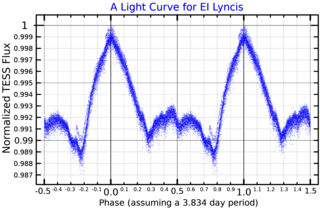
36 Lyncis is a solitary variable star located around 620 light years away from the Sun in the northern constellation of Lynx. It has the variable star designation of EI Lyncis, while 36 Lyncis is the Flamsteed designation. This object is visible to the naked eye as a dim, blue-white hued star with an apparent visual magnitude of 5.30. It is moving further away from the Earth with a heliocentric radial velocity of 21 km/s.
Theta Hydri, Latinized from θ Hydri, is the Bayer designation for a blue-white hued star in the southern constellation of Hydrus. It is faintly visible to the naked eye with an apparent visual magnitude of +5.53. Based upon an annual parallax shift of 6.50 mas as seen from Earth, is located approximately 502 light years from the Sun. At that distance, the visual magnitude of the star is diminished by an extinction of 0.10 due to interstellar dust. It is moving away from the Sun with a radial velocity of +12.3 km/s.
KS Persei is a binary system in the equatorial constellation of Perseus. It is sometimes known as Bidelman's Star, named after William P. Bidelman. The star is invisible to the naked eye with a mean apparent visual magnitude of 7.70. As of 2018, the structure and evolutionary history of this system remain uncertain, although some form of mass transfer is likely to have occurred to explain the observed properties.

HD 125248 is a binary star system in the equatorial constellation of Virgo. It has the variable star designation CS Virginis, while HD 125248 is the designation from the Henry Draper Catalogue. This system is dimly visible to the naked eye as a point of light with an apparent visual magnitude that ranges from 5.84 down to 5.95. It is located at a distance of approximately 280 light years from the Sun based on parallax measurements, but is drifting closer with a heliocentric radial velocity of −8 km/s.

CQ Ursae Majoris is a variable star in the northern circumpolar constellation of Ursa Major, abbreviated CQ UMa. It is sometimes identified as HR 5153 from the Bright Star Catalogue or HD 119213 in the Henry Draper Catalogue; CQ UMa is the variable star designation. The star ranges in apparent visual magnitude from 6.28 to 6.30, which is bright enough to be dimly visible to the naked eye. It is located at a distance of 296 light years from the Sun based on parallax measurements.
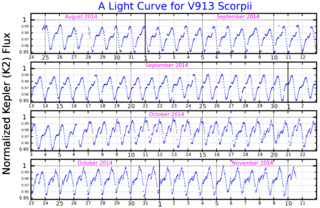
HD 142990, also known as HR 5942 and V913 Scorpii, is a star about 470 light years from the Earth, in the constellation Scorpius. It is a 5th magnitude star, so it will be faintly visible to the naked eye of an observer far from city lights. It is a variable star, whose brightness varies slightly from 5.40 to 5.47 during its 23.5 hour rotation period. It is a member of the Upper Scorpius Region of the Scorpius–Centaurus association.

HD 28843, also known as HR 1441 and DZ Eridani, is a star about 550 light years from the Earth, in the constellation Eridanus. It is a 5th magnitude star, so it will be faintly visible to the naked eye of an observer far from city lights. It is a variable star, whose brightness varies slightly from 5.70 to 5.84 during its 1.374 day rotation period. It is a member of the μ Tauri Association, a group of young stars within the larger Cassiopeia-Taurus Structure.

V686 Coronae Australis is a solitary, bluish-white-hued variable star located in the southern constellation Corona Australis. It has an apparent magnitude that ranges between 5.25 and 5.41, which makes it faintly visible to the naked eye. Gaia DR3 parallax measurements imply a distance of 480 light years and it is slowly receding with a heliocentric radial velocity of 1.3 km/s. At its current distance V686 CrA's average brightness is diminished by 0.35 magnitudes due to extinction from interstellar dust and it has an absolute visual magnitude of −0.24.

HD 187474, also known as HR 7552 and V3961 Sagittarii, is a star about 315 light years from the Earth, in the constellation Sagittarius. It is a 5th magnitude star, so it will be faintly visible to the naked eye of an observer far from city lights. It is a variable star, whose brightness varies slightly from magnitude 5.28 to 5.34. HD 187474 is classified as an Alpha2 Canum Venaticorum variable star, but it has a rotation period of 2345 days - more than an order of magnitude longer than is typical for that class. HD 187474 is an Ap star.


















